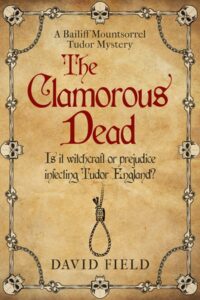Congratulations to David Field, whose Victorian thriller, The Long Delayed Revenge, is out now!
The Long Delayed Revenge is the tenth instalment in the Esther and Jack Enright Mystery Series – a traditional British detective series set in Victorian London and packed full of suspense.
London, 1899

Jack and Esther Enright, with their four children in tow, have recently moved to a comfortable new home. Esther has settled into her dream job as headmistress of the local private school, owned by her mentor Emily Allsop.
But things are not going so well for Jack. Though he does not mind the commute to his high-ranking desk job at New Scotland Yard, he is disturbed by the level of recent resignations in by uniformed constables in the East End.
Though the police force has always been used to tackling crime in the more impoverished parts of London, a recent influx of Russian immigrants has led to gang warfare and vigilante justice which is proving impossible to control.
And when Esther’s school is vandalised with a disturbing message, he finds his detective skills are needed closer to home as well.
Things escalate when one of the young pupils is abducted and Jack needs all the help he can get in finding the perpetrator before it is too late.
Can Jack and Esther solve another case together? Will they rescue the child in time?
Or will the unrest in London prove too much for even Jack to handle…?
Congratulations to David Field, whose twisty Victorian thriller, The Retirement Murder, is out now!
The Retirement Murder is the ninth instalment in the Esther and Jack Enright Mystery Series – a traditional British detective series set in Victorian London and packed full of suspense.
London, 1898
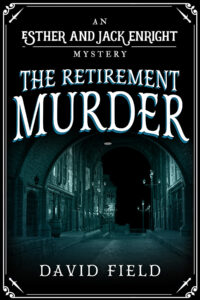
The time has finally come for Percy Enright to retire from Scotland Yard. His nephew, Jack, is sad to lose a partner in the force, but Jack’s wife Esther is glad Percy won’t be getting her husband into any further scrapes.
It seems Esther’s relief might be short lived, though, when a senior officer collapses at Percy’s farewell ceremony.
It soon becomes clear that the officer was poisoned, and Percy delays retirement to help Jack track down the culprit.
It’s a daunting task that involves trawling through all the murdered officer’s recent cases in the search for someone who may still bear him a grudge.
But when it becomes clear the dead man may not have been the intended target, the investigation suddenly turns in a new direction.
Why are the police being targeted? Can Percy make one final arrest before he retires?
Or will the murderer outwit the Enrights in their latest case…?
Congratulations to David Field, whose absorbing historical thriller, Death By Gunpowder, is out now!
Death By Gunpowder is the sixth instalment of the Bailiff Mountsorrel Tudor Mystery Series – private investigation crime novels set during the reign of Elizabeth I and beyond.
Nottingham, England, 1605
Frustrated in their two previous attempts to restore the Catholic faith to England, a group of heretics plan to assassinate King James in Parliament in a massive explosion timed for November 5th, 1605.
But when that plot also fails and Guy Fawkes starts revealing the names of accomplices under torture in the Tower, those who had been complicit in the plot run for cover.
Not long after, Nottinghamshire bailiff, Edward Mountsorrel is called to investigate a mysterious explosion in a row of houses that has left four people dead.
And he soon unearths evidence that suggests this crime is linked to the larger plot on the king’s life.
His suspicions are confirmed when an official from London, acting with royal authority, orders Edward and fellow bailiff Francis Barton to hunt down the gunpowder fugitives who are believed to be hiding out in the local area.
But the men won’t go down without a fight. And Edward could find himself in the firing line…
Following the success of his many historical series, including The Bailiff Mountsorrel Tudor Mysteries and The Medieval Saga Series, we are delighted to announce that we have signed a new series focusing on the Plantagenet dynasty by David Field.
In David’s words:
“It’s so good to be in a relationship with a publisher who likes what you write, and encourages you to write more of it. A marriage made in typescript, so to speak.
“Some years ago, Publishing Director Amy Durant liked my idea of viewing English history through the eyes of ordinary folk, beginning with the conquest of England by William of Normandy in 1066. This became The Medieval Saga Series, which followed the fortunes of several fictional families over two hundred years, ending with the death of Simon de Montfort in 1265.
“I had also written a Tudor series for Sapere that began with the life of Henry VII, who became king in 1485, and ended with the reign of Elizabeth I. As I looked wistfully at the remaining gap of over two hundred years, I couldn’t help wanting to write about that period. ‘Go for it’ was Amy’s response, and The Plantagenet Series was born. It will span from 1265 to 1485, and will involve later generations of the fictional family that readers first met in 1066. When completed, Sapere will have published a novel of mine featuring every English ruler from Harold Godwinson to Elizabeth I. That’s what I call an enduring marriage!”
Congratulations to David Field, whose gripping historical mystery, To Kill A King, is out now!
To Kill A King is the fifth novel in the Bailiff Mountsorrel Tudor Mystery Series – private investigation crime novels set during the reign of Elizabeth I and beyond.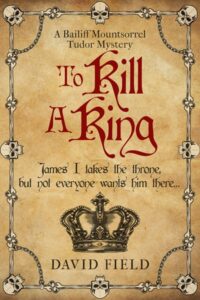
Nottingham, England, 1603
Queen Elizabeth’s long reign has finally come to an end and the Tudor era is over. Scottish King James has been handed the crown of England, but not everyone is happy about that, and there are several plots being hatched to replace him with an alternative.
Bailiff Edward Mountsorrel already has his hands full with an increase in destitute vagrants flooding the county, who seem to be victims of a human trafficker. But before he can find the man responsible, he is tasked by an official with royal authority to infiltrate a local group, who it is rumoured are plotting to assassinate the new king.
Edward enlists the help of fellow bailiff, Francis Barton to find the group, who are hiding out in Sherwood Forest.
But the only way to discover the plot is to place themselves right in the heart of the danger. And there’s a good chance they will be killed before they can save the king…
Who is leading the band of rebels? Can he be stopped?
And is there a connection between the treasonous plot and the desperate vagrants Edward is trying to assist…?
Congratulations to David Field, whose twisty Elizabethan mystery, The Clamorous Dead, is published today!
The Clamorous Dead is the fourth historical thriller in the Bailiff Mountsorrel Tudor Mystery Series – private investigation crime novels set during the reign of Elizabeth I and beyond.
A routine hanging at Gallows Hill is disrupted when a wild woman begins screaming a curse on the execution site, calling down nightly visitations from the undead to claim the souls of the living.
County Bailiff Edward Mountsorrel attempts to pursue her, but she vanishes into thin air.
Nightly thereafter, Gallows Hill is the scene of ghastly happenings that Edward is ordered to investigate. Rumours of witchcraft infiltrate the county and the bailiff is sent to arrest a local woman, suspected of devilry.
Edward finds her and realises she is merely a wise woman with ancient knowledge of herbs and medicine and with no ill intent. He decides to hide her to keep her safe from those calling for blood.
But his efforts are complicated by the arrival of a professional witch-hunter from Scotland, who is scouring the length and breadth of England in a blood-thirsty mission to destroy any woman, man or child found guilty of sorcery.
As mass hysteria and prejudice threaten to engulf the country, can Edward bring justice to his county, while still keeping his morals intact? Or will innocent women be thrown to the wolves…?
In this behind-the-scenes blog series, Sapere Books authors offer an intriguing insight into how, where and why they write.
Today, we are delighted to spotlight David Field, author of numerous historical series including the Bailiff Mountsorrel Tudor Mystery Series and the New World Nautical Saga Series.
I’ve always written stories, even as a child, then I progressed from childhood scribbles to more serious attempts at literary glory on an old upright Olivetti typewriter (one of those with a red and black ribbon, if you’re old enough to remember) when my handwriting graduated from ‘untidy’ to ‘execrable’.
Reluctantly I then honoured my mother’s wish, and my father’s insistence, and got a ‘real job’ as a criminal trial lawyer, which was about as relaxing as standing on one leg on the top outer ledge of The Shard in London, without the reassurance of a safety harness. To relieve the stress I decided to start working on a novel — but what should I choose for a genre?
A good friend of mine who already earned a precarious living as a novelist was insistent that one should always write about things that one knows, and by this stage I knew two things outside my professional straightjacket — some history from my schooldays, and the streets of my home town, Nottingham. During the final years of my working life I spent stolen moments imagining the lives of those living in Nottingham during the Luddite Riots, and In Ludd’s Name was eventually published by a boutique publishing house owned by an old school friend.
Bitten by the bug, and buoyed up by having finally been published, I grew ambitious, and searched the history books for possible storylines, most notably from that most colourful of periods of English history, the Tudor era. The literary world seemed to be awash with Henry VIII, Anne Boleyn, Elizabeth I and even ‘Bloody Mary’, but two seminal characters from that era seemed never to have received much attention from novelists.
First was the progenitor of the Tudors, the boy from Wales, Henry VII, and I climbed inside his head to bring to the pages that followed his boyhood imprisonment in a bleak castle in South Wales, his youthful exile in Brittany, his triumphant return at the head of a ramshackle army that deposed Richard III at Bosworth, and his love match with Elizabeth of York that brought the Wars of the Roses to an end in the nursery rather than on the battlefield. To my delight, and secret surprise, I found a publisher — Sapere Books — and Tudor Dawn was launched.
Then — unbounded joy and amazement! — Sapere wanted another one, so this time I focused on a butcher’s son from Ipswich who rose from obscurity to become Archbishop of York, Papal Legate for life, Lord Chancellor and the diplomacy coach of choice of Henry VIII. Cardinal Thomas Wolsey’s spectacular downfall was just as dramatic, and The King’s Commoner was published, as testament to the fact that I had a second novel in me.
Dozens of titles have since been published, all by Sapere Books, and all ‘historical’ in genre. As one of the characters in Alan Bennett’s delightful creation, The History Boys, says of history — ‘It’s just one ******* thing after another’, and so it has been for me.
Congratulations to David Field, whose gripping historical mystery, The Slaughtered Widow, is published today!
The Slaughtered Widow is the third instalment of the Bailiff Mountsorrel Tudor Mystery Series – private investigation crime novels set during the reign of Elizabeth I and beyond.
Town Bailiff Francis Barton has been arrested for the murder of his former lover, the widow Agnes Timberlake, and the case against him is a strong one.
Agnes was hacked to death where she lay in her bed and Francis was found standing next to her body, with both his clothing and his sword covered in her blood.
And there is a motive. Agnes had recently loaned Francis her entire life savings and was believed to be demanding an accounting for them.
Despite the overwhelming evidence against him, Francis’s friend, County Bailiff Edward Mountsorrel, refuses to believe that Francis is guilty and sets out to investigate for himself.
Edward wants to speak to the serving girl from the widow’s house who may have been the last to see her mistress alive, but she has vanished.
Is the girl running from a guilty conscience? Or has she also fallen victim to the killer?
Time is running out for Francis. Can Edward clear his friend’s name … or is it time to accept that Francis really is capable of murder…?
Congratulations to David Field, whose absorbing historical thriller, The Assassination Players, is published today!
The Assassination Players is the second instalment in the Bailiff Mountsorrel Tudor Mystery Series – private investigation crime novels set during the reign of Elizabeth I and beyond.
Nottinghamshire, England, 1591
Two of Queen Elizabeth I’s justices have been murdered within a week of each other, along with a woman who was involved with one of them and a man who had been awaiting trial by the other.
County Bailiff Edward Mountsorrel and Town Bailiff Francis Barton are tasked with investigating the deaths, but they are thrown off course by a visit from the queen’s secretary, Baron Burghley.
Burghley has discovered a plot to kill the Protestant queen and replace her with a Catholic alternative.
He tasks the bailiffs with journeying into a neighbouring county to infiltrate the gang of suspected traitors.
Time is of the essence as the threat already seems to have infiltrated Elizabeth’s court.
But the men behind the plot are ruthless and the path to discover them is fraught with danger.
Will Mountsorrel and Barton unmask the traitors? Who is behind the plot to kill the queen?
Can the bailiffs stop them before they change the course of history forever…?
Congratulations to David Field, whose page-turning Tudor mystery, The Castle Abductions, is out now!
The Castle Abductions is the first historical thriller in the Bailiff Mountsorrel Tudor Mystery Series: private investigation crime novels set during the reign of Elizabeth I and beyond.
County Bailiff Edward Mountsorrel and Town Bailiff Francis Barton have vowed to root out the criminals of Nottinghamshire and bring them to justice.
But after acting on information from a questionable source, Edward is tricked into allowing several deer to be stolen from a local estate. Furious, he sets about tracking them down.
Meanwhile, Francis is asked to investigate the disappearance of Nell, a young woman who was last seen at a local alehouse with a wealthy stranger.
When the bailiffs’ shared house is burned down and their servant is found stabbed to death, Edward and Francis begin to suspect that their cases are linked.
And when more young women go missing, the two bailiffs worry they are running out of time to retrieve them from danger…
Who wishes to silence to Edward and Francis? What happened to the missing women?
And can the two bailiffs find them before it’s too late…?
David Field is the author of numerous historical series, including the Bailiff Mountsorrel Tudor Mystery Series: private investigation crime novels set during the reign of Elizabeth I and beyond.
My new series features the exploits of two sheriffs’ bailiffs during the Tudor and later the Stuart eras. For me it was a labour of love because it involved researching the history of Nottingham, where I was born and raised during the immediate post-war years.
In my novels, Edward Mountsorrel and Francis Barton are colleagues in adjoining jurisdictions who have become close friends. Their work involves enforcing the law and investigating crime, under the direction of their respective employers, the Sheriff of Nottinghamshire and the Sheriff of Nottingham. The fact that there are two separate sheriffs, one for the county and the other for the town, arises from a quirk of Nottingham’s history that also explodes one of the elements of the legend of Robin Hood, Nottingham’s most famous alleged resident.
A central character in the Robin Hood myth is the dastardly Sheriff of Nottingham, but the truth is that he did not exist until 1449, at least two hundred years after Robin is said to have lurked in Sherwood Forest, to the north of the town. A charter in that year, granted by Henry VI, made Nottingham its own county, with its own sheriff and its own jurisdiction, not to mention its own courthouse. And therein lies another set of intriguing and quirky facts.
While the town continued to conduct its legal affairs in the old Guildhall in Weekday Cross, the county needed a place to do the same, conveniently located within the town itself. It therefore constructed what for many years was known as the Shire Hall, sitting proudly in the middle of one of the town’s most affluent streets, High Pavement. It was a small chunk of the county located within the town, and given that the boundary line ran through the centre of the original courtroom, the judge could be found seated in the town while the prisoner before him was located in the county. This august building is now the National Justice Museum, a popular destination for tourists.
Hopefully this will make up for several guaranteed disappointments for any tourist visiting Nottingham hoping to step into the Medieval world of Robin Hood. The city does indeed possess a castle, which features heavily in the first book in my forthcoming series, but the current edifice is now in its third manifestation. The original eleventh-century version constructed on the orders of William the Conqueror was destroyed at the behest of its own governor, Colonel John Hutchinson, at the end of the English Civil War, before Oliver Cromwell could get his hands on it. The reconstruction was then burned down by a mob during the Reform Bill Riots of 1831, and the current building — which is now a civic museum that houses old bicycles, coin collections and Japanese armour — became little better than a middle-class boarding house of dull Victorian architecture before being bought up for a song by the embarrassed city fathers.
At least the vandals couldn’t do much to diminish the grandeur of the rock on which the castle stands, a block of sandstone rising for one hundred and thirty feet above ground level. This is full of caves and passages where previous generations cut their way through the soft stone in order to create dwellings that were converted into dungeons when the castle was first constructed. At its foot sits a vintage hostelry, now known as The Ye Olde Trip to Jerusalem, that was once the castle’s in-house brewery before it became an alehouse, linked to the castle above by a series of tunnels through the sandstone. This alehouse would have been there during the time in which my novels are set, so I’ve made use of it in the first instalment, in which young women are abducted from there.
I enjoyed researching the history of my birthplace, and I think it shows in my new series, which hopefully captures the rough-and-tumble nature of law enforcement in a Tudor township.
Congratulations to David Field, whose enthralling naval adventure, Westward To Freedom, is out now!
Westward To Freedom is the third Tudor/Renaissance novel in The New World Nautical Saga Series – historical novels set during the reign of Elizabeth I and beyond.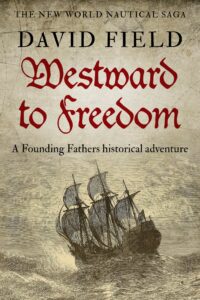
1607
The English Separatists seek only the right to be allowed to worship in their own way in their humble North Nottinghamshire village, but their beliefs are anathema to King James.
When they are given cause to believe that their clandestine meetings have come to the notice of the authorities they move to Gainsborough with a view to taking ship to the Low Countries.
After being betrayed three times they eventually make it to the comparative safety of Holland, but even there they are in danger of persecution.
So in one final throw of the dice they sign up to be members of a ‘settler’ community financed by merchant adventurers.
But to start their new life they must survive the perilous crossing on The Mayflower.
And the wilderness waiting for them on the other side is not quite what they had hoped for.
Will they succumb to the elements, disease or starvation?
Or will fortune shine on this assembly of pilgrims and finally allow them a sanctuary of their own creation?
Congratulations to David Field, whose thrilling maritime adventure, Beyond The Setting Sun, is published today!
Beyond The Setting Sun is the second Tudor novel in The New World Nautical Saga Series – historical adventures set during the reign of Elizabeth I and beyond.
England, 1580
Walter Raleigh dreams of the unknown lands that lie over the distant western horizon. He had grown up believing that if you journey too far you risk falling off the side of the earth. But now, intrepid mariners are telling stories of new lands, blessed with limitless riches that await those bold enough to claim them.
Raleigh’s patron, Queen Elizabeth is easily seduced by the prospect of amassing a great fortune for her war chest and agrees to finance his quest.
But the seas are unpredictable, and when his first attempt fails, he fears his adventuring days may be over.
Weaving tales of the legendary land of El Dorado, city of gold, Raleigh successfully persuades Elizabeth to grant him a charter to explore a passage through the Americas to the South Seas.
And this time, he successfully sets up a colony in the New World.
Virginia is born, in honour of the great monarch who sanctioned its creation.
But what dangers are waiting the intrepid settlers? Will they find themselves in a new heaven – or a fresh Hell?
Congratulations to David Field, whose gripping nautical adventure, Pirates and Patriots, is out now!
Pirates and Patriots is the first novel in The New World Nautical Saga Series: historical adventures set during the reign of Elizabeth I and beyond.
England, 1554
Fifteen-year-old Francis Drake is realising his dream of sailing on the open seas. After training with his cousins William and John Hawkins in their naval business, he takes his first commission upon the Bonaventure.
But when disaster strikes the ship and Francis saves the men with his quick-thinking, he makes an enemy of the captain, who threatens to charge Francis with mutiny.
Francis must seek a new path to make his fortune and he joins with the Hawkins brothers to search for glory in foreign lands.
But trading on the world stage is already being dominated by Spanish and Portuguese explorers and so Francis must act quickly if he wishes to make his mark.
And as one Tudor queen makes way for another, and Spanish relations grow ever tenser, Francis Drake may soon be needed to help save his country from the threat of war…
Congratulations to David Field, whose absorbing historical saga, The Conscience of a King, is published today!
The Conscience of a King is the final instalment of The Medieval Saga Series – thrilling action-packed adventures set during and after the Norman Conquest.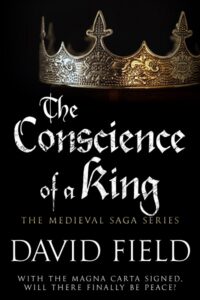
England, 1229
After fighting in the Albigensian Crusade in France, Simon de Montfort – a landless nobleman – arrives at the court of Henry III, hoping to re-establish his family’s claim to the Earldom of Leicester.
In pursuit of his goal, Simon soon proves his value to Henry as a military leader and political advisor, becoming one of the king’s most trusted men.
But discontent is building within the English court. Frustrated by the king’s preference for foreign nobles and his extortionate taxes to fund wars abroad, the leading barons are constantly on the edge of rebellion.
As a man with a strong sense of justice, Simon is dismayed by Henry’s treatment of the common people and the corruptibility of the English legal system. And as the barons’ anger seems set to boil over into armed conflict, Simon must search his conscience and decide how far he is willing to go to bring about reform…
Can Simon restore his family’s fortunes? Can he help lead England into a new golden age while retaining the king’s favour?
Or will his principles cost him his life…?
We are thrilled to be celebrating five years in business this month and we are incredibly grateful to all the writers, agents and literary estate holders who have helped us bring to market such a vibrant and diverse list of books.
Since launching Sapere Books in March 2018, our list has grown to include over six-hundred books by over one hundred authors. We have sold over 3 million books to date with 500 million pages read through Amazon’s Kindle Unlimited program.
In 2019, we employed our first full-time staff member, Natalie Linh Bolderston, who now holds the title of Assistant Editor, and in 2020, Matilda Richards and Helen Jennings both also joined our editorial team. They have all been essential to our ongoing success and we are over the moon that they are continuing the journey with us as we celebrate our first big milestone.
In 2020, we launched our non-fiction list, which includes classic works by authors such as E R Chamberlin, Sir Peter Gretton and John Bowle. And we are now pleased to announce that we are also hiring another staff member to help look after our burgeoning military history and military fiction list.
Since launching, we have focussed primarily on fiction, particularly historical fiction and crime fiction, and in 2021 we created our first historical writing contest, asking for entrants to submit a series outline loosely based on briefs we set. The response was so strong that as well as signing up five prize-winners we also signed ten more authors from the shortlisted entries.
We have always been keen to foster a community among our authors. In 2020, to combat some of the isolation due to the pandemic, we started running weekly Zooms for our authors to join and chat about their writing. These have become a valuable part of our ethos and we want to continue to make our authors feel welcomed, valued and part of the Sapere Books family.
We are also proud to announce that we have been certified Carbon Neutral since 2021 and we have created our own Sapere Books forest, planting a tree for every author that we work with.
We look forward to continuing to build strong relationships within the writing community and to publishing more brilliant genre fiction to capture the imagination of readers. Thank you again to everyone who has supported us and we hope you continue to love our books!
Amy, Richard and Caoimhe
Testimonials from four of the authors who launched with us in 2018:
David Field, author of the Medieval Saga series, the Tudor Saga series and many more
By one of life’s happy coincidences, I came across Amy Durant just when the publisher that had commissioned my first historical novel series decided to close down. Five years later I’ve published over twenty historical novels with Sapere, with ten more waiting to go.
When you become a member of the Sapere family, you’re all set for a rewarding writing career. If the quality’s right, you know that your latest ‘baby’ will be assured of a good home. They provide great editing, superb covers, expert marketing, regular royalty payments and guaranteed replies to your emails. Sapere authors have indeed been smiled upon by the patron saint of aspiring writers.
Keith Moray, author of the Inspector Torquil McKinnon series
Being published by Sapere Books has been a revelation for me as a writer. From the very first moment that Isabel Atherton, my agent at Creative Authors, arranged a chat with Amy Durant it has been a fabulous experience. Over the past five years, I have seen my backlist of fiction published along with five new novels, and I have three more under contract. Every aspect of book production from editing, cover design, publicity and marketing has been handled with flair and efficiency. On top of that, communication could not be easier or quicker, and Sapere Books have created a friendly atmosphere among all of the authors that makes me feel pleased to be part of the Sapere Books family. I could not be happier than I have been with Sapere Books, who are in my opinion without parallel in the publishing industry.
Linda Stratmann, author of The Early Casebook of Sherlock Holmes and the Mina Scarletti Mysteries
Becoming a Sapere Books author is like joining a warm and welcoming family, dedicated to providing the best for authors and readers. An experienced and hardworking team offers a soundly professional service, always on hand for support and advice. The last five years has seen Sapere grow and flourish, but never losing that personal touch.
Elizabeth Bailey, author of the Lady Fan Mystery series
Working with Sapere has been the most enjoyable and rewarding publishing experience in all my thirty-odd years as an author. That my career is flourishing is testament to the care and attention given to every book. Authors are encouraged to interact and support each other, which makes me feel part of a family, parented by the nurturing and talented Sapere team. Long may they reign! Oh, and we all love our covers!
Congratulations to David Field, whose gripping historical saga, The Road to Runnymede, is out now!
The Road to Runnymede is the sixth historical novel in The Medieval Saga Series – thrilling action-packed adventures set during and after the Norman Conquest.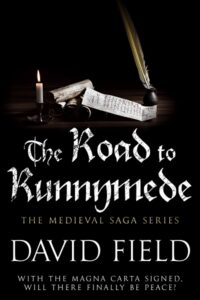
England, 1199
After the death of Richard the Lionheart, his brother, John takes the English throne with the support of his mother, Eleanor of Aquitaine.
But John has a rival in the person of young Arthur, Duke of Brittany, who Richard had acknowledged as his rightful heir.
Arthur’s claim is the superior one under Angevin law, and it is backed by the majority of the nobles in Maine and Anjou, supported by King Philip II of France, who is anxious to break up the Angevin Empire.
John’s preference for foreign favourites, his heavy taxation of the English nobility to fund his military failures, his brutal reaction to opposition and his belief in his divine right to rule provoke a powerful group of barons into a rebellion.
But when John agrees to sign the Magna Carta, a fragile peace is restored.
It doesn’t take long for John to renege on his word. And the barons respond by inviting the young Prince Louis of France to invade.
In the midst of all this chaos, Earl Hugh of Flint, together with his powerful cousin Earl Ranulf of Chester, find themselves reluctantly serving a king who is destroying their country from within.
Their lives, their families and their estates are continually at risk as England turns on itself.
Who will emerge victorious? Will a new king bring stability?
Or is England doomed to once more be thrown into a period of turmoil…?
Congratulations to David Field, whose gripping historical saga, The Absentee King, is published today! The Absentee King is the fifth book in the Medieval Saga series.
Richard the Lionheart has been crowned King of England.
But his obsession with fighting in the Third Crusade sends him off to foreign lands.
The nation is left in a perilous state, with high public offices sold off, and trusted favourites left to rule during Richard’s absence.
Richard’s dissolute and envious younger brother John feels humiliated, not least when Richard declares his four-year-old nephew Prince Arthur to be his heir, and he causes unrest throughout the nation by enforcing harsh laws designed to keep the population under his iron fist.
Chief Justice, Earl William of Repton, is ordered to investigate the possibility that John is seeking to undermine his brother Richard’s rule.
And when news reaches England that King Richard has been captured, and is being ransomed by Henry VI of Germany, William becomes convinced that John is plotting to seize the English crown.
Will Richard be released? Will he return to claim his throne?
Or will John succeed in his mission to overthrow the absentee king…?
Congratulations to David Field, whose dramatic medieval thriller, An Uncivil War, is published today!
England, 1120
When Henry I dies with no legitimate male heir, the nation is thrown into chaos.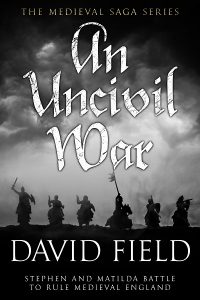
The two rivals for the crown are Henry’s daughter Matilda and his nephew Stephen of Blois, both of whom are determined to emerge victorious.
A bitter struggle ensues which threatens to reduce England to a barren wasteland and many ordinary people find themselves torn apart from each other in the confusion of deciding which side to fight for.
One of those caught up in the fray is young soldier Richard Walsingham who is fighting alongside Stephen. But his sister Elinor is employed as a companion to Matilda.
As the family members come to terms with being on opposite sides of a treacherous dynastic conflict a new contender for the throne enters the picture…
Which of the rivals will emerge triumphant? Can the nation be pieced back together again?
Or will more than lives be lost in this uncivil war…?
Congratulations to David Field, whose gripping medieval thriller, Traitor’s Arrow, is published today!
When King William Rufus of England is killed mysteriously during a hunting accident in the New Forest in 1100, his younger brother Henry, who had been present, loses no time in riding hard to claim both the Treasury and the crown.
Rumours quickly being swirling that Henry was himself responsible for Rufus’s death. One of Henry’s main accusers is his older brother Robert, Duke of Normandy, who believes the throne of England is his by right and threatens to invade from across the Channel.
King Henry entrusts the task of proving his innocence to Sir Wilfrid Walsingham, a Saxon-born knight who was elevated by Henry’s father, only to be cast by the perverted and tyrannical Rufus into a jail cell from which, after almost two years, few men could have emerged alive, or with their sanity intact.
Can Walsingham unearth the truth about Rufus’s death and clear his name? Or will England be torn apart by those in power…?
Click here to order Traitor’s Arrow
Congratulations to David Field, whose thrilling Medieval saga, Conquest, is published today!
 It’s 1065 and the Saxon kingdom is under threat of invasion at both ends. From the north comes Harald Hardrada of Norway intent on pillage, while across the Channel, Duke William of Normandy is about to enforce his claim to the throne.
It’s 1065 and the Saxon kingdom is under threat of invasion at both ends. From the north comes Harald Hardrada of Norway intent on pillage, while across the Channel, Duke William of Normandy is about to enforce his claim to the throne.
Between the two lie the villages and townships defended only by part-time armies maintained by the Earls of Wessex, Mercia and Northumbria, barely united under King Harold Godwineson.
It falls to brave and determined young men like Will Riveracre and Selwyn Astenmede to stand firm against whichever marauding invader reaches them first.
But the initial battle could be the least of their worries as a new king ascends the throne – threatening to annihilate their traditions and customs forever…
Congratulations to David Field, whose thrilling historical saga, All That Glitters, is published today!
All That Glitters is the final instalment of The Australian Saga Series, set in the eighteenth and nineteenth centuries.
 Lawyer Jack Bradbury is called upon to travel to the newly established Colony of Victoria to defend a man wrongly accused of attempted murder during a confrontation between the authorities and a group of gold prospectors.
Lawyer Jack Bradbury is called upon to travel to the newly established Colony of Victoria to defend a man wrongly accused of attempted murder during a confrontation between the authorities and a group of gold prospectors.
Following his success he’s recruited by the miners’ leader to assist them in their battles against the colonial government and is joined in his new home by his wife and children.
But Jack and his family soon find themselves caught up in the affairs of the Kelly family whose black sheep Edward, known to everyone as ‘Ned’, courts trouble wherever he goes.
Their lives are about to be disrupted and sent down avenues they had never anticipated…
Click here to order All That Glitters
Following the publication of David Field’s absorbing Esther & Jack Enright Mysteries, Tudor Saga Series and Carlyle & West Victorian Mysteries, we are delighted to have signed up his new Medieval Saga Series.
In David’s words:
“I consider myself blessed to have found Sapere Books, who not only share my enthusiasm for historical novels, but also provide the most generous author royalties in the business, and never lose sight of the fact that their many authors have invested a massive amount of emotional energy into creating, nurturing, and revealing their characters.
“It’s therefore with great optimism and a sense of purpose that I’ve embarked on my latest venture with them — the Medieval Saga Series, a set of seven novels that follow the fortunes of the same family from immediately prior to the Battle of Hastings all the way through to the death of Simon de Montfort in the Battle of Evesham in 1265.
“The first in the series — THE CONQUEST — introduces the Riveracres, a Saxon family living on the Sussex coast whose tiny village is directly in the path of Duke William of Normandy’s invasion army, and the Astenmedes, the local Thegn’s brood whose traditional privileged status is about to be shattered. Amidst the turmoil, two brave men, Will Riveracre and Selwyn Astenmede, form an unlikely partnership as they stand against both Duke William and Harald Hardrada’s invading Viking force to the north.”
Click here to find out more about the Esther & Jack Enright Mysteries
Click here to find out more about the Tudor Saga Series
Click here to find out more about the Carlyle & West Victorian Mysteries
David Field is the author of the Carlyle & West Victorian Mysteries.
As a historical novelist in search of bygone eras to recreate, I’ve always been fascinated by the late Victorian period. It was a time of contrasts, with vast scientific, medical and technological breakthroughs coming at a time when ordinary folk were obsessed with communicating with the dead. Victoria seemed destined to rule forever over a rich empire, while her subjects in its industrial cities, and most notably in its London capital, were existing in conditions of abject poverty.
Following the success of my Esther & Jack Enright mystery series, which began with the search for Jack the Ripper and ended just as the nineteenth century was about to, I was urged to return to this rich seam of inspiration, and there was – for me, at least – one obvious place to start.
When Arthur Conan Doyle abandoned medical practice and created his fascinating character Sherlock Holmes, he was inspired by his memory of a real life Sherlock. His name was Dr Joseph Bell, and he had taught anatomy to his classes of medical students at Edinburgh University, one of whom had been Doyle himself. Bell had what was then a unique approach to his analysis of the cadavers that were to be found on his mortuary slab, something that is second nature to modern forensic examiners, but was revolutionary in its day. He approached ‘cause of death’ by examining, not just insides of the bodies, but the clothing and personal possessions with which they arrived, and telltale indications on the skin, such as needle marks, abrasions, rough working hands and suchlike. From this he made logical deductions that were of value to police in unexplained death enquiries, and he taught his students to apply the same techniques when they went out into the world.
There must have been several generations of medical graduates from Edinburgh who were taught ‘the Bell method’, and it was no great stretch of the imagination for me to create Dr James Carlyle, anatomist and general surgeon at Whitechapel’s London Hospital – a medical doctor with the same professional training as Conan Doyle and the same inquisitive, logical mind as Joseph Bell.
His first challenge – described in the first novel in my new series, INTERVIEWING THE DEAD – is to debunk the panicked belief among the populace of the East End that the spirits of those buried in a Plague Pit in Aldgate have returned to take their revenge for the disturbance of their resting place. That belief has taken hold easily, given the obsession with Spiritualism that gripped the country during this period.
But there were also other ‘spirits’ abroad, and they were advocating for great social change. Chief among these were the Suffragists, who campaigned for ‘votes for women’ and Suffragettes who took on entire police forces in public demonstrations. There were also other groups of feminists, as we would call them today, who advocated for equality of admission to professions such as medicine and the law. This was how Dr James Carlyle’s daughter, Adelaide, was created, as a young woman whose opinion of men and their dominance of society could not have been any lower – until she meets my third new character, Matthew West.
Although the Anglican Church was ahead of all other Protestant movements in the 1890s, it was demonstrating a social elitism that drove away ordinary working folk, and left the pastoral door open for more working-class religious initiatives and crusades among the poor. ‘Methodism’ had become a religious movement of its own, with its own hierarchy, but its progenitor, ‘Wesleyism’, still had its head above the parapet, and Wesleyan street preachers such as Matthew West might be found on corners, in market places, and outside factory and dockside gates.
Matthew has his own reasons for wishing to hose down any belief in the return of vengeful spirits of the dead, and when he finds himself associated with Dr Carlyle in the search for the truth, he comes up against the fiery Adelaide, who works as her father’s assistant. They influence each other’s views on life as they are drawn imperceptibly into a mutual attraction.
The stage is set for my next series. I hope you’ll join me in following the exploits of this unlikely trio, and I look forward to learning your reaction to them.
Click here to pre-order INTERVIEWING THE DEAD!
Happy new year to all of our wonderful authors and readers, and thank you for your continued faith and support! 2019 saw us expand our list with some incredible titles and we can’t wait to share more with you this year.
Here’s what to expect from 2020:
We will soon launch our non-fiction list, led by Sapere co-founder Richard Simpson. Richard is on the lookout for military history titles – backlist in particular – and aims to launch the first few books on our second anniversary in March.
Our ‘call for nautical fiction’ has been successful and we will soon be releasing Irving A. Greenfield’s Depth Force series – thrilling submarine adventures set in the 90s, as well as the first in a series of Second World War naval thrillers by Justin Fox, and a trilogy of Tudor nautical adventure books by David Field.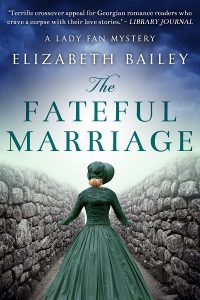
We also have plenty of exciting new projects from our current authors, so look out for the next books in the series you already love! These include the final instalment of Alexandra Walsh’s Marquess House Trilogy; the next ghostly adventure in Linda Stratmann’s Mina Scarletti series; a new Lady Fan regency mystery from Elizabeth Bailey and a return of Charles Dickens as private investigator in J C Briggs’ Victorian series.
We also have brand new authors launching next year and plenty more fan favourites! Make sure you sign up to our newsletter to stay up to date with our latest releases and monthly deals.
This Christmas, we’ve put together an anthology of festive crime fiction that is sure to give you the chills! Here’s a taste of what to expect from MIDWINTER MYSTERIES…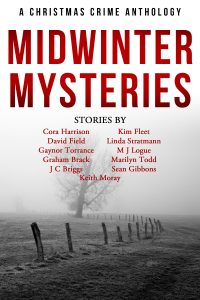
In Graham Brack’s AWAY IN A MANGER, a decidedly non-festive Lieutenant Josef Slonský investigates a string of thefts amid Prague’s bustling Christmas market.
At a Christmas Eve gathering, Charles Dickens weaves a gory, atmospheric ghost story that becomes a little too real in J C Briggs’ FOOTPRINTS IN THE SNOW.
Keith Moray’s LOST AND FOUND follows the residents of West Uist as they merrily prepare for their New Year’s Eve traditions – until one of them is found dead…
While trying to provide for his family, young Alfie finds himself investigating the disappearance of gold bars from a bullion store – which have vanished along with his beloved dog, Mutsy – in Cora Harrison’s THE SPIRIT OF CHRISTMAS.
In Seán Gibbons’ THE STOLEN SANTA SACK, unlucky driver Ben Miller is stuck with a dead Santa Claus and a sackful of cash in the back of his cab…
While hurrying to develop her clients’ portraits in time for Christmas, photographer Julia McAllister is landed with a drunken newlywed and a photograph of a ghost in Marilyn Todd’s WILL POWER.
Gaynor Torrance’s CHRISTMAS SPIRITS follows headstrong Detective Inspector Jemima Huxley as she finds herself caught up in an armed robbery while doing her Christmas shopping.
In David Field’s THE ESSEX NATIVITY, Detective Sergeant Jack Enright discovers a destitute couple expecting their first child in the shelter of a barn.
When one of her clients is stalked by a mysterious figure, Private Investigator Eden Grey attempts to uncover the unwelcome follower in Kim Fleet’s SECRET SANTA.
Major Thankful and Thomazine Russell investigate the theft of a scandalous manuscript written by the king in M J Logue’s STIR UP SUNDAY.
In Linda Stratmann’s THE CHRISTMAS GHOST, wilful sleuth Mina Scarletti attempts to bring peace to a woman haunted by the spirit of her dead son.
Click here to order MIDWINTER MYSTERIES!
David Field is the author of The Tudor Saga Series. The Queen In Waiting is the fifth book in the series.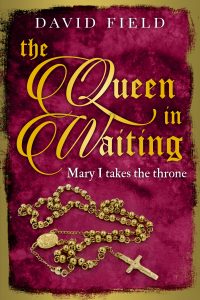
There were many victims during that turbulent period in English history that we call the Tudor era, and not all of them were obvious. ‘Popular’ history has a habit of creating fixed mental images of those who lived their lives in the maelstrom of Tudor Court politics, and it’s only when you examine the actual facts that the doubts begin to creep in. A prime example of a Tudor ‘identity’ whose place in the ‘fake news’ of the period has set her character in concrete is Mary Tudor, the only child of Henry VIII and his first – and longest lasting – Queen, Katherine of Aragon. Mention Mary and the word ‘Bloody’ appears like magic before her name, conjured up by usage and with little regard to the circumstances that led her to burn Protestants at the stake.
Mary was born in February 1516, the only surviving child from her mother Katherine’s long and miserable litany of stillbirths and miscarriages. Katherine may well have suffered from gynaecological problems that Mary inherited, because Mary is recorded as having endured menstrual disorders as a young woman. These were no doubt the early warnings of the phantom pregnancies and uterine blockages that would deny her issue of her own, and lead ultimately to her death.
But in her very early years we are given a picture of a rosy-cheeked, chuckling little infant with her father’s distinctive red hair being bounced gleefully on Henry’s knee as he resolutely hid from the world his inner torment that Mary was not a boy. His obsession with begetting a male heir, more perhaps than any natural lust for Anne Boleyn, led to Katherine’s eclipse, and as she entered puberty Mary was forced to watch from very distant sidelines as her beloved mother suffered the public humiliation of the annulment of her marriage to Henry, and her replacement on the throne by ‘the night crow’ Anne Boleyn. Anne completed the insult by giving birth, in almost indecent haste, to Mary’s half-sister Elizabeth.

Mary Tudor
Humiliation was piled on humiliation as Mary was declared a bastard, and her place in the succession was taken by Elizabeth. The newly demoted ‘Lady Mary’ was stripped of her own former household and sent to live with Elizabeth in Hatfield House, Hertfordshire, denied access to her mother Katherine, who pined her way to a heartbroken death in a remote castle in Cambridgeshire. Mary was reported to have been ‘inconsolable’ at her mother’s death, and suffered from unspecified illnesses for several years during which she was estranged from her father.
The execution of Anne Boleyn and the bastardisation of Elizabeth would have been of little comfort to Mary once Henry’s new wife Jane Seymour gave birth to the heir apparent Edward, who, under the baleful influence of the Seymours who governed the nation as part of his Regency Council, proved to be far more aggressively Protestant than his late father, while Mary was equally determined to both pursue and promote the Catholic religion of her late mother. The two never saw eye to eye, and during a disastrous attempt at reconciliation during the Christmas of 1550, the thirty-four year old Mary was reduced to tears when rebuked by her thirteen year old half-brother, in front of the entire Court, for her fervent adherence to her faith.
The death of Edward was probably the greatest catalyst for Mary’s subsequent actions. It was learned that in his fear that England would slide back into Catholicism should Mary become Queen, Edward had bequeathed the throne to their distant cousin Jane Grey, from an obscure Leicestershire offshoot of the wider Tudor family. Not only that, but the Council of State initially supported Jane, and Mary was obliged to claim her throne by superior force of arms.
She was now 37, beyond the customary ‘sell by’ date of Tudor women, unmarried, childless, and suffering from gynaecological issues. She was probably both flattered and relieved to receive an offer of marriage from her second cousin Philip of Spain. There seems to be little doubt that for him it was a marriage of greed, furthering his ambition to rule most of Europe, but for Mary it seems to have been a love match. Then history repeated itself through a phantom pregnancy and a terrible slow decline with what may well have been ovarian cancer. One can only feel desperately sorry for the lonely old woman on her death bed when one reads that, on learning of Mary’s demise, Philip wrote to his sister that “I felt a reasonable regret for her death.”
Is it surprising that Mary Tudor was hardly a bundle of laughs during her lifetime? Her mother was publicly humiliated, she herself was bastardised by her loving father, her half brother ridiculed her faith, her Council of State preferred a country girl over her as Queen, and her younger sister was prettier, more socially accomplished, and more loved by the people, while her husband regarded sexual relations between them as some sort of public duty. Add to that her almost permanent ill-health, and it is difficult not to reach behind the public persona she left behind in order to give her a consoling cuddle.
In the latest novel in my Tudor series, The Queen in Waiting, I chose to depict the reign of Mary through the eyes of Elizabeth, another victim of their times. I could only describe the events of Elizabeth’s life through the actions of Mary, and they were harsh when considered without regard to the events that forged them. Sinned against or sinning? Your choice.
Order THE QUEEN IN WAITING here.
Or find out more about The Tudor Saga Series here.
Image credit: Portrait of Mary I of England and Ireland by Hans Eworth. (Public domain).
It’s a truism that history is a set of facts left to posterity by the winners, and for historical novelists like me there’s always another ‘take’ on every so-called ‘fact’ we’re taught at school. A prime example of that is the enduring legend of ‘The Princes in the Tower’.
The first to get their stories organised were the Tudors who benefitted considerably from the unexplained disappearance from the Tower of London of the Yorkist royal heirs Edward, Prince of Wales, and Richard, Duke of York. 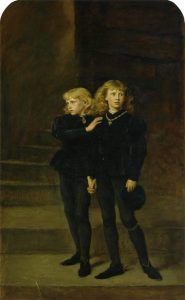
When Henry Tudor defeated Richard of Gloucester in an obscure field in Leicestershire we now know as ‘Bosworth’ (even though that town didn’t exist then), there was no one left on the Yorkist side to challenge his claim to the throne, given that the princes were no more. But it was essential to point the finger away from ‘the person most likely’ – the obvious suspect for the disappearances/deaths, and the Tudor propaganda machine swung into action.
Sir Thomas More possible lived to regret the assistance he gave to Henry VIII in perpetuating the myth that the person behind the disappearances of the princes from the Tower had been a close relative of theirs, namely their uncle. But More was the first to point the written finger at Richard of Gloucester, particularly after Sir William Tyrell, during the reign of Henry Tudor, allegedly confessed to having done the job in the pay of Richard. But tortured men will eventually say whatever their torturers want to hear, and the alleged confession came, second hand, through the mouth of the torturer.
 Never one to miss an opportunity to ingratiate himself with a royal patron, that literary prostitute William Shakespeare built Thomas More’s accusation into a horror story of a crook-backed, slew-footed, psychopathic freak who did away with anyone who stood between him and the throne. Actors such as Laurence Olivier and Benedict Cumberbatch then provided us all with a visual image to go with the verbal hype. The net result of all this ‘fake news’ was that we all grew up believing that Richard III had done for the two little boys under his guardianship.
Never one to miss an opportunity to ingratiate himself with a royal patron, that literary prostitute William Shakespeare built Thomas More’s accusation into a horror story of a crook-backed, slew-footed, psychopathic freak who did away with anyone who stood between him and the throne. Actors such as Laurence Olivier and Benedict Cumberbatch then provided us all with a visual image to go with the verbal hype. The net result of all this ‘fake news’ was that we all grew up believing that Richard III had done for the two little boys under his guardianship.
But spin the wheel 180 degrees, and there was someone else who benefitted equally from a sudden absence of Yorkist claimants to the English throne. He had an alibi, of course, because at the most likely date of the crime – the Summer of 1483 – he, Henry Tudor, was in exile in Britanny.
But back home in England, ‘Mummy’, the formidable, wily, scheming Margaret Beaufort, was preparing the runway for her favourite son’s safe landing with an invasion force. She also had a useful second son – Henry’s half-brother the Duke of Buckingham – who was Lord High Constable of England, with responsibilities that included security at the Tower of London. Go figure, as they say.
Having written a novel from the Tudor perspective (The Flowering of the Tudor Rose), and having suffered death by blog from dedicated ‘Ricardians’, I took up the case for the defence in Justice for the Cardinal, due for publication by Sapere Books later this year. The central character in this novel is Richard Ashton, grandson of the Duke of York who escaped from the Tower, only to be executed under his assumed name of ‘Perkin Warbeck’ by a paranoid Henry VII.
‘You pays your money . . . .’, as the old saying goes. The jury will forever remain out on who really ordered the murder of the princes. In the meantime, we historical novelists can play on both halves of the pitch.

